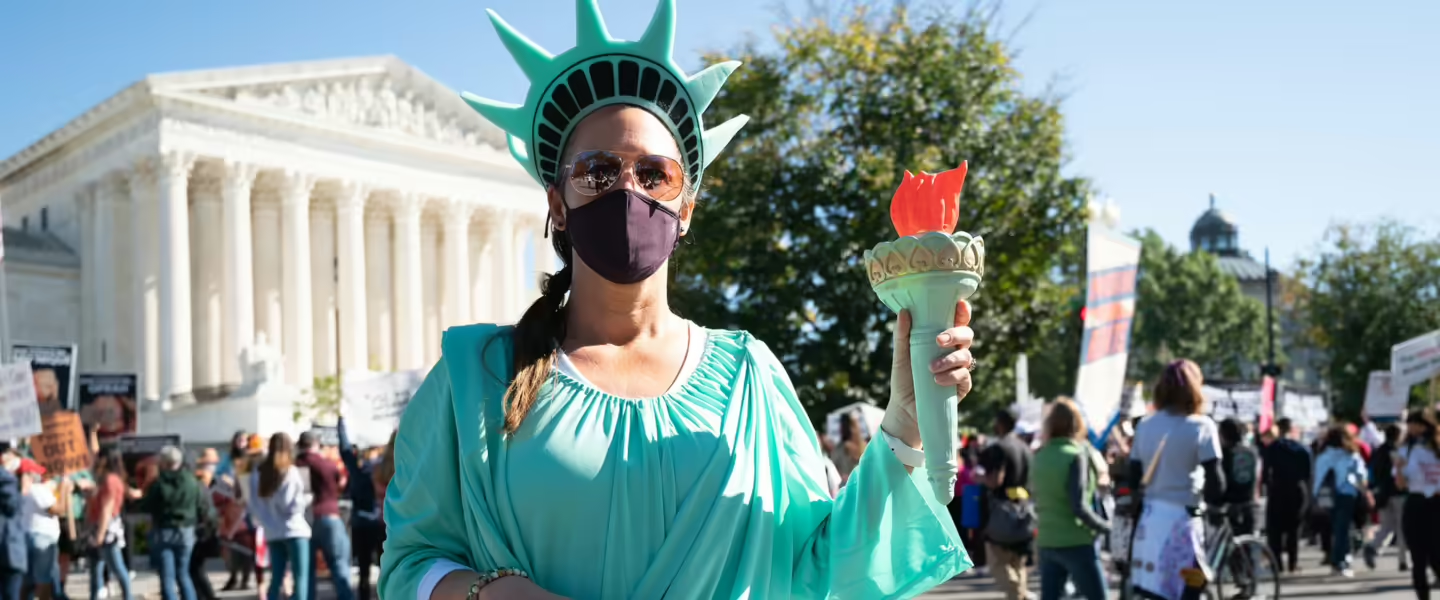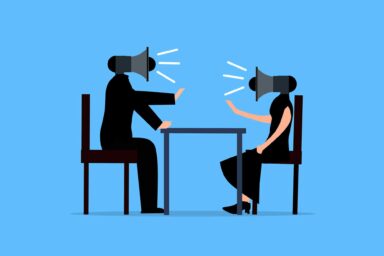What happened to women voters as Harris drew fewer of them than Biden in 2020? Even in pro-choice strongholds, economic concerns trumped reproductive rights.
The great female firewall against Trump’s return never materialized. In fact, it crumbled.
Vice President Kamala Harris, who should have been a powerful draw for women voters, actually performed worse than Joe Biden did in 2020, capturing just 54 percent of women’s votes compared to his 57 percent.
Even more stunning: In states like Ohio and Kentucky, where women had recently mobilized to protect reproductive rights, the expected momentum vanished. What happened?
The answer challenges everything we thought we knew about women voters in post-Roe America. While pundits focused on reproductive rights and the historic nature of Harris’s candidacy, women voters turned out to be part of the 74 percent of voters who were sending a “wrong track” message.
Why wasn’t the issue of reproductive rights enough to change this dynamic? What does this election mean for the future of abortion rights? Will it impact the midterms with a small electorate as it did in 2022? Did pundits only imagine a “war on women”?
To examine this I’m joined on this week’s WhoWhatWhy podcast by Amanda Becker. Becker is a 2023 Nieman Fellow and Washington correspondent for The 19th. She is the author of the book You Must Stand Up: The Fight for Abortion Rights in Post-Dobbs America, and has covered the US Congress, the White House, and elections for more than a decade.
 Apple Podcasts
Apple Podcasts Google Podcasts
Google Podcasts RSS
RSS
Full Text Transcript:
(As a service to our readers, we provide transcripts with our podcasts. We try to ensure that these transcripts do not include errors. However, due to a constraint of resources, we are not always able to proofread them as closely as we would like and hope that you will excuse any errors that slipped through.)
Jeff Schechtman: Welcome to the WhoWhatWhy Podcast. I’m your host, Jeff Schechtman. Right up until the votes started being counted, conventional wisdom held that women would be the firewall against Trump’s return. The theory was simple. The Dobbs decision hadn’t just changed a law, it had redrawn the map of America by creating a patchwork nation where a woman’s zip code determines her reproductive rights. It was believed that women, especially young women, would reshape the electoral landscape. After all, imagine waking up one morning to find that the medical care you needed yesterday is now a crime.
For millions of American women, this wasn’t hypothetical, it was reality. My guest today has watched this transformation up close and personal. As the ink was still drying on the Supreme Court’s opinion, she hit the road, crisscrossing the country to capture a pivotal year in American history. Her book, You Must Stand Up, is a dispatch from the front lines of a revolution, from emergency room doctors suddenly questioning every decision to kitchen table activists finding their voice for the first time.
She stood face to face with the people living and fighting for reproductive rights. So what happened? Why did women give VP Harris only 54% of their vote versus 57% for Joe Biden in 2020? And why even in states like Kansas and Kentucky, where women who had made their voices heard in elections to preserve their rights, now turn to Trump. We’re going to talk about all of this with my guest, Amanda Becker, a 2023 Nieman Fellow and Washington correspondent for the 19th. She’s covered the US Congress, the White House in elections for more than a decade. It is my pleasure to welcome Amanda Becker here to the program. Amanda, thanks so much for joining us here on the WhoWhatWhy Podcast.
Amanda Becker: Thanks for having me.
Jeff: Well, it is a delight to have you here. As you look at what has transpired over the past 48 hours, particularly as respect to women and how they voted, what is your main takeaway from all of these?
Amanda: That women, just like pretty much every other demographic group in this country, shifted to Trump this year. Really the only demographic we’re seeing that didn’t is Black women, and white women shifted away by one point overall. But women overall shifted in Trump’s direction, just as men did and people across the socioeconomic spectrum in most cases. This really I think we’ll be sorting through what this all means for years, not days or weeks, or months. And I think that there’s going to be some serious introspection in the Democratic Party about their messaging to voters and what they’re promising to them and why the voters don’t seem to be responding.
Jeff: The abortion issue was a fundamental issue into the 2022 midterm elections. It seems to have changed dramatically in two years.
Amanda: I’m not sure that we can extrapolate that actually. Because first of all, all of the ballot measures related to abortion passed except for Florida and Nebraska. There were 10 states that had it. Florida, even though it didn’t pass, that’s the one I have flagged in the past as being the least likely to pass because it required hitting a 60% threshold.
Jeff: But it still got 57%.
Amanda: Correct. And so there’s still a majority of voters and not a small majority. That’s a pretty sizable majority in US politics that wanted that ballot measure. And I would not be shocked if they try and bring that back in an off-year election because the electorate is different when a president is not on the ticket. People are less tribal. And I would not be surprised if they re-attempt that in Florida. In Nebraska you had two competing measures. And after a series of legal challenges, most of which were brought by abortion opponents, the language on those ballot measures was really confusing.
And so that one isn’t a huge surprise either, though I did think it had more of a chance of passing than Florida did simply because of that 60% threshold. So there’s that. So the electorate showed in ballot measures that they still care very much about abortion. When you looked at the exit polling of issues that people were most concerned about, actually democracy was tied with the economy in most exit polls, which is surprising. Normally in past polls, democracy doesn’t really show up as an issue.
I have been writing about how voters are increasingly making the connection between abortion and democracy, and below democracy and the economy is the top issues, the third was still abortion. And it was tracking exactly what the polls showed going into election day in the exit polls. And so I think the abortion ballot measures outperformed Vice President Harris in every case that I’ve seen so far. And we’ll continue to get new numbers as we get better numbers, of course. So I don’t know that we can say that this election is because the electorate didn’t care about abortion.
I think it’s just manifesting in ways that were unpredictable, which was always going to be the case to some degree going into this.
Jeff: Was there a concern as there was talk early on in the election cycle of a national ban and the fear of that? Talk about that.
Amanda: Absolutely. So one thing that I’m really interested in exploring as we get more detailed, voter data and also as places start to do focus groups with voters because you can only really tell so much from the polls. They tell you their top issues and who they voted for and basic demographic info, but they don’t go into the why. And so we need to wait for focus groups and just good old-fashioned shoe leather reporting out there in the field by people like myself to find out what voters were thinking about abortion when they cast their ballots.
Former President Donald Trump, and now President-elect Donald Trump, on October 1st finally said he would veto a national abortion ban. He had skirted around the issue before that. So I’m wondering if that gave people a peace of mind who care about this issue, that a national abortion ban would not be implemented and that freed them up to vote for him.
And I also think that part of it was a lack of education among the electorate that there’s many, many things a president can do beyond a national abortion ban that aren’t even in the extreme project 2025.
They could simply just have the Justice Department stop defending the emergency medicine law. That is that case in a couple of different cases related to state abortion bans and whether emergency medicine law still requires hospitals in those states to treat patients who are miscarrying, who might need an emergency abortion. The conversation about abortion in this election, and this partially falls on the shoulders of my profession, was simply about no ban or a ban nationally. And they didn’t get into any of the specifics.
So unless a voter was reading news outlets like mine that were covering the nuance or doing the research on their own, it was going to be very difficult for them to get a full picture of how a Trump presidency could affect abortion access.
Jeff: What about Harris’s argument on the other hand, that there was this desire to enshrine Roe into law?
Amanda: That was also never going to happen. I mean, I wrote a story about how we were, as a country, having the wrong conversation about abortion in this election. Because unless one party or the other got a filibuster-proof majority in the senate, which neither of them had any real chance of getting, they’re not going to be able to get abortion legislation through Congress, whether it’s a ban or a bill codifying Roe. And so that was kind of a red herring in this debate about abortion in the buildup to voting that I think really didn’t leave people with a fully accurate picture of what the parameters of the debate were.
Jeff: And what does this election mean then, as best you can tell at this point for the future of reproductive rights battles state by state?
Amanda: I mean, so I would expect more states to float ballot measures where they think that they can pass and where ballot measures are an available tool because only 26 states have citizen-offered ballot measures. So not every state can do that. The citizens can’t. So I would expect more of those in two years and in four years. I would expect an administration here, the incoming Trump administration, to do things that will affect abortion access, and we’ll see whether the public is aware of what is going on and the impact it’s having in their communities and whether that affects races in two years.
Because I do think that abortion rights if you look at some of these competitive senate races, most of the Democratic women squeaked through and a couple of the men didn’t. And that was in Montana that they didn’t. The Democrats lost a seat also in Ohio, but the women came through in Michigan, Wisconsin. And Nevada is another good example. Those were all races where it was not only women running, but abortion rights were a huge part of their campaigns.
And I think we’ve seen that women can run on this in a way that even men who support abortion rights can’t necessarily or it’s just a little bit different. It comes across different to the electorate. So I would not be surprised if we get data at some point that shows that abortion is what got some of those senate candidates over the finish line.
Jeff: But didn’t do very much for Harris.
Amanda: No. I mean, she underperformed the ballot measures and she underperformed the senators.
Jeff: And you were mentioning some of the states. Ohio is an interesting case where Moreno was just adamant about a complete restriction on abortion.
Amanda: And he also said that older women wouldn’t care. And one of the narratives going into the final days of the race was that why would women over 50 care? Women over 65 care? We actually saw women over 65 move to Harris more than some groups that are of reproductive age because these women are at an age and some of these men care about this issue as well. They remember what it was like pre-roll. And so I think that abortion likely informed some of that piece of the electorate moving the women over 65, even though they can’t have children anymore.
But they have daughters, they have granddaughters, they care. One woman put it to me, I care about all women, not just myself. And so when you had a candidate like Bernie Moreno dismissing that, you would’ve thought that would hurt him. But another wrinkle is that Ohioans protected abortion access by ballot measure last year. So maybe that just wasn’t as salient of an issue in that race in Ohio between Sherrod Brown and Bernie Moreno.
Jeff: Talk a little bit about the degree to which you think this will continue as a significant political issue.
Amanda: Early days, I do think it’s going to continue to be important because we’re just starting to hear the stories of the people who have died linked to abortion bans. We as a country are very early into this experiment of having 50 different approaches to abortion because each state is now coming up with their own. And I think that we will continue to see this play out. And it will we’ll continue to see an impact. I don’t know that we know exactly how right now. I think some of it will depend on what happens when Trump’s administration comes into Washington and what they do.
If they do things like decline to intervene in cases with states like Texas and Idaho that are arguing that their hospitals don’t need to treat patients who are in emergencies and need abortions, that could heat this on the public’s radar in a way that could start to impact candidate races. The big question going into this election for me was how do all these ballot initiatives impact candidate races or not. And how does the issue impact candidate races or not? And we saw that in the presidential, it doesn’t seem to have had any impact.
Jeff: Not only does this not seem to have had an impact, but some of the other issues that were often put in this basket of war against women don’t seem to have had much of an impact either when we look at the bottom line here.
Amanda: Yes. I’ll read you just some exit polling data that I’ve been working with today to work on a story. So in 2020, among 18 to 24-year-old women, 74% voted for Biden. That number dropped to, and it’s not a full-like like because it’s 18 to 29 for this year for some reason the way they did it, but it’s 61% this year. And it was across the board, as I said, for everyone except for the 65 and older women. I think that we’ll be trying to figure out what happened in this election for a while.
I think that anyone who says they know right now exactly what went on with women in this election is not telling the truth because [chuckles] I think that people are going to be sorting through this for quite a while to try to figure out what the takeaways are for a group of people in this country. The majority don’t seem to be concerned about– Well, I guess that’s not fair because 54% so close to a majority, close to half don’t seem to be concerned about some of these issues that might affect their lives in a very real way.
Jeff: And what are you hearing from women that you talk to and in your reporting about this as there is this criticism, where were you, what happened?
Amanda: Things fall into two camps. I’m about to go through some data and some interviews with women who both support abortion rights and voted for Trump. I think that’ll be really interesting. I’m excited to go through that. Obviously, for the women who have been working on this issue of abortion rights and who thought it could really make a difference in this election, especially once a woman was at the top of the Democratic ticket, to say they are devastated today and yesterday is really an understatement.
And I think that a test of their movement will be, do they keep going with the same energy and intensity that they have been the past couple of years because it has been an intense effort across this country, especially in the battleground states, especially in states where rights are in flux related to abortion. And do they give up? Are they tired? Are they demoralized or do they keep up the fight? And I think that we’ll start to see that over the next three to six months, if not definitely over the next two years before the midterms.
Jeff: Amanda Becker, thank you so much for shedding some light on this subject and spending some time with us today here on the WhoWhatWhy Podcast.
Amanda: Of course, I wish I could shed more. Maybe when we get that validated voter data.
Jeff: Well, thank you so much.
Amanda: Thank you.
Jeff: And thank you for listening and joining us here on the WhoWhatWhy Podcast. I hope you join us next week for another Radio WhoWhatWhy Podcast. I’m Jeff Schechtman. If you like this podcast, please feel free to share and help others find it by rating and reviewing it on iTunes. You can also support this podcast and all the work we do by going to whowhatwhy.org/donate.



